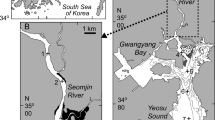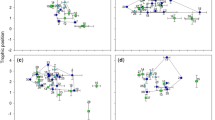Abstract
Seasonal oscillations in the carbon (δ13C) and nitrogen (δ15N) isotope signatures of aquatic algae can cause seasonal enrichment–depletion cycles in the isotopic composition of planktonic invertebrates (e.g., copepods). Yet, there is growing evidence that seasonal enrichment–depletion cycles also occur in the isotope signatures of larger invertebrate consumers, taxa used to define reference points in isotope-based trophic models (e.g., trophic baselines). To evaluate the general assumption of temporal stability in non-zooplankton aquatic invertebrates, δ13C and δ15N time series data from the literature were analyzed for seasonality and the influence of biotic (feeding group) and abiotic (trophic state, climate regime) factors on isotope temporal patterns. The amplitude of δ13C and δ15N enrichment–depletion cycles was negatively related to body size, although all size-classes of invertebrates displayed a winter-to-summer enrichment in δ13C and depletion in δ15N. Among feeding groups, periphytic grazers were more variable and displayed larger temporal changes in δ13C than detritivores. For nitrogen, temporal variability and magnitude of directional change of δ15N was most strongly related to ecosystem trophic state (eutrophic > mesotrophic, oligotrophic). This study provides evidence of seasonality in the isotopic composition of aquatic invertebrates across very broad geographical and ecological gradients as well as identifying factors that are likely to modulate the strength and variability of seasonality. These results emphasize the need for researchers to recognize the likelihood of temporal changes in non-zooplankton aquatic invertebrate consumers at time scales relevant to seasonal studies and, if present, to account for temporal dynamics in isotope trophic models.




Similar content being viewed by others
References
Cabana G, Rasmussen JB (1994) Modeling food chain structure and contaminant bioaccumulation using stable nitrogen isotopes. Nature 372:255–257
Cabana G, Rasmussen JB (1996) Comparison of aquatic food chains using nitrogen isotopes. Proc Natl Acad Sci USA 93:10844–10847
Carlson RE (1977) Trophic state index for lakes. Limnol Oceanogr 22:361–369
Cattaneo A, Manca M, Rasmussen JB (2004) Peculiarities in the stable isotope composition of organisms from an alpine lake. Aquat Biol 66:440–445
Cherel Y, Hobson KA, Bailleul FR, Groscolas R (2005) Nutrition, physiology, and stable isotopes: new information from fasting and molting penguins. Ecology 86:2881–2888
Finlay JC (2001) Stable carbon isotope ratios of river biota: implications for energy flow in lotic food webs. Ecology 82:1052–1064
Finlay JC (2004) Patterns and controls of lotic algal stable carbon isotope ratios. Limnol Oceanogr 49:850–861
Finlay JC, Khandwala S, Power ME (2002) Spatial scales of carbon flow in a river food web. Ecology 83:1845–1859
Fry B (1988) Food web structure on Georges Bank from stable C, N, and S isotopic compositions. Limnol Oceanogr 33:1182–1190
Grey J, Jones RI, Sleep D (2001) Seasonal changes in the importance of the source of organic matter to the diet of zooplankton in Loch Ness, as indicated by stable isotope analysis. Limnol Oceanogr 46:505–513
Gu B (2009) Variations and controls of nitrogen stable isotopes in particulate organic matter of lakes. Oecologia 160:421–431
Gu B, Alexander V, Schell DM (1999) Seasonal and interannual variability of plankton carbon isotope ratios in a subarctic lake. Freshw Biol 42:417–426
Gu BH, Schelske CL, Waters MN (2011) Patterns and controls of seasonal variability of carbon stable isotopes of particulate organic matter in lakes. Oecologia 165:1083–1094
Hastie T, Tibshirani R (1990) Generalized additive models. Chapman and Hall, New York
Hill WR, Middleton RG (2006) Changes in carbon stable isotope ratios during periphyton development. Limnol Oceanogr 51:2360–2369
Hobson KA (1999) Tracing origins and migration of wildlife using stable isotopes: a review. Oecologia 120:314–326
Hobson KA, Alisauskas RT, Clark RG (1993) Stable nitrogen isotope enrichment in avian tissues due to fasting and nutritional stress—implications for isotopic analyses of diet. Condor 95:388–394
Horrigan SG, Montoya JP, Nevins JL, Mccarthy JJ (1990) Natural isotopic composition of dissolved inorganic nitrogen in the Chesapeake Bay. Estuar Coast Shelf Sci 30:393–410
Jardine TD, Kidd KA, Fisk AT (2006) Applications, considerations, and sources of uncertainty when using stable isotope analysis in ecotoxicology. Environ Sci Technol 40:7501–7511
Kankaala P, Taipale S, Li L, Jones RI (2010) Diets of crustacean zooplankton, inferred from stable carbon and nitrogen isotope analyses, in lakes with varying allochthonous dissolved organic carbon content. Aquat Ecol 44:781–795
Lake JL et al (2001) Stable nitrogen isotopes as indicators of anthropogenic activities in small freshwater systems. Can J Fish Aquat Sci 58:870–878
Leggett MF, Johannsson O, Hesslein R, Dixon DG, Taylor WD, Servos MR (2000) Influence of inorganic nitrogen cycling on the δ15N of Lake Ontario biota. Can J Fish Aquat Sci 57:1489–1496
Merritt RW, Cummins KW (2008) An introduction to the aquatic insects of North America, 4th edn. Kendall/Hunt, Dubuque
Mook WG, Bommerso JC, Staverma WH (1974) Carbon isotope fractionation between dissolved bicarbonate and gaseous carbon dioxide. Earth Planet Sci Lett 22:169–176
Nordström M, Aarnio K, Bonsdorff E (2009) Temporal variability of a benthic food web: patterns and processes in a low-diversity system. Mar Ecol Prog Ser 378:13–26
Pace ML, Cole JJ, Carpenter SR, Kitchell JF, Hodgson JR, Van de Bogert MC, Bade DL, Kritzberg ES, Bastviken D (2004) Whole-lake carbon-13 additions reveal terrestrial support of aquatic food webs. Nature 427:240–243
Perga ME, Gerdeaux D (2005) ‘Are fish what they eat’ all year round? Oecologia 144:598–606
Phillips DL, Gregg JW (2001) Uncertainty in source partitioning using stable isotopes. Oecologia 127:171–179
Phillips DL, Newsome SD, Gregg JW (2005) Combining sources in stable isotope mixing models: alternative methods. Oecologia 144:520–527
Polis GA, Strong DR (1996) Food web complexity and community dynamics. Am Nat 147:813–846
Post DM (2002) Using stable isotopes to estimate trophic position: models, methods, and assumptions. Ecology 83:703–718
Rasmussen JB (2010) Estimating terrestrial contribution to stream invertebrates and periphyton using a gradient-based mixing model for δ13C. J Anim Ecol 79:393–402
Rasmussen JB, Trudeau V (2007) Influence of velocity and chlorophyll standing stock on periphyton δ13C and δ15N in the Ste. Marguerite River system, Quebec. Can J Fish Aquat Sci 64:1370–1381
Semmens BX, Ward EJ, Moore JW, Darimont CT (2009) Quantifying inter- and intra-population niche variability using hierarchical Bayesian stable isotope mixing models. PLoS One 4:e6187
Syvaränta J, Hämäläinen H, Jones RI (2006) Within-lake variability in carbon and nitrogen stable isotope signatures. Freshw Biol 51:1090–1102
Trudeau V, Rasmussen JB (2003) The effect of water velocity on stable carbon and nitrogen isotope signatures of periphyton. Limnol Oceanogr 48:2194–2199
Vander Zanden MJ, Rasmussen JB (1999) Primary consumer δ13C and δ15N and the trophic position of aquatic consumers. Ecology 80:1395–1404
Vander Zanden MJ, Rasmussen JB (2001) Variation in δ15N and δ13C trophic fractionation: implications for aquatic food web studies. Limnol Oceanogr 46:2061–2066
Vizzini S, Mazzola A (2005) Feeding ecology of the sand smelt Atherina boyeri (Risso 1810) (Osteichthyes, Atherinidae) in the western Mediterranean: evidence for spatial variability based on stable carbon and nitrogen isotopes. Environ Biol Fish 72:259–266
Woodland RJ, Rodríguez MA, Magnan P, Glèmet H, Cabana G (2011) Incorporating temporally dynamic baselines in isotopic mixing models. Ecology. doi:10.1890/11-0505.1
Zohary T, Erez J, Gophen M, Bermanfrank I, Stiller M (1994) Seasonality of stable carbon isotopes within the pelagic food web of Lake Kinneret. Limnol Oceanogr 39:1030–1043
Acknowledgments
This research was supported by grants from the Fonds Québécois de la Recherche sur la Nature et les Technologies (FQRNT), the Natural Sciences and Engineering Research Council of Canada (NSERC) and Université du Québec à Trois-Rivières.
Conflict of interest
The authors declare that they have no conflict of interest.
Author information
Authors and Affiliations
Corresponding author
Additional information
Communicated by Robert Hall.
Electronic supplementary material
Below is the link to the electronic supplementary material.
Rights and permissions
About this article
Cite this article
Woodland, R.J., Magnan, P., Glémet, H. et al. Variability and directionality of temporal changes in δ13C and δ15N of aquatic invertebrate primary consumers. Oecologia 169, 199–209 (2012). https://doi.org/10.1007/s00442-011-2178-7
Received:
Accepted:
Published:
Issue Date:
DOI: https://doi.org/10.1007/s00442-011-2178-7




